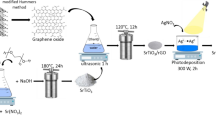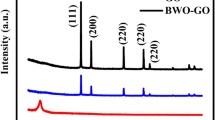Abstract
Response surface methodology (RSM) was employed to optimize the control parameters of TiO2/graphene with exposed {001} facets during synthesis, and its enhanced photocatalytic activities were evaluated in the photodegradation of toluene. Experimental results were in good agreement with the predicted results obtained using RSM with a correlation coefficient (R2) of 0.9345. When 22.06 mg of graphite oxide (GO) and 2.09 mL of hydrofluoric acid (HF) were added and a hydrothermal time of 28 h was used, a maximum efficiency in the degradation of toluene was achieved. X-ray diffraction (XRD), transmission electron microscopy (TEM), and scanning electron microscopy (SEM) were employed to characterize the obtained hybrid photocatalyst. The electron transferred between Ti and C retarded the combination of electron–hole pairs and hastened the transferring of electrons, which enhanced the photocatalytic activity.









Similar content being viewed by others
References
Datye AK, Riegel G, Bolton JR et al (1995) Microstructural characterization of a fumed titanium dioxide photocatalyst. J Solid State Chem 115(1):236–239
Chen M, Goodman D (2004) The structure of catalytically active gold on titania. Science 306(5694):252–255
Linsebigler AL, Lu G, Yates JT Jr et al (1995) Photocatalysis on TiO2 surfaces: principles, mechanisms, and selected results. Chem Rev 95(3):735–758
Fujishima A, Rao TN, Tryk DA et al (2000) Titanium dioxide photocatalysis. J Photochem Photobiol C 1(1):1–21
Carp O, Huisman CL, Reller A et al (2004) Photoinduced reactivity of titanium dioxide. Prog Solid State Chem 32(1):33–177
Liu B, Zeng HC (2008) Carbon nanotubes supported mesoporous mesocrystals of anatase TiO2. Chem Mater 20(8):2711–2718
Geim AK (1995) Graphene: Status and prospects. Science 324(5934):1530–1534
Lee C, Wei X, Kysar JW et al (2008) Measurement of the elastic properties and intrinsic strength of monolayer graphene. Science 321(5887):385–388
Wang L, Pu KY, Li J et al (2011) A graphene–conjugated oligomer hybrid probe for light-up sensing of lectin and Escherichia coli. Adv Mater 23(38):4386–4391
Chen JS, Liu H, Qiao SZ et al (2011) Carbon-supported ultra-thin anatase TiO2 nanosheets for fast reversible lithium storage. J Mater Chem 21(15):5687–5692
Zhu PN, Nair AS, Peng SJ et al (2012) Facile fabrication of TiO2–graphene composite with enhanced photovoltaic and photocatalytic properties by electrospinning. ACS Appl Mater Interfaces 4(2):581–585
Zhang H, Pan X, Liu JJ et al (2011) Enhanced catalytic activity of sub-nanometer titania clusters confined inside double-wall carbon nanotubes. Chem Sus Chem 4(7):975–980
Wen CZ, Jiang HB, Qiao SZ et al (2011) Synthesis of high-reactive facets dominated anatase TiO2. J Mater Chem 21(20):7052–7061
Rashid U, Anwar F, Arif M et al (2009) Optimization of base catalytic methanolysis of sunflower (Helianthus annuus) seed oil for biodiesel production by using response surface methodology. Ind Eng Chem Res 48(4):1719–1726
Sahu J, Acharya J, Meikap B et al (2009) Response surface modeling and optimization of chromium (VI) removal from aqueous solution using Tamarind wood activated carbon in batch process. J Hazard Mater 172(2–3):818–825
Miyagi Y, Shima F, Ishido K et al (1999) Tremor induced by toluene misuse successfully treated by a Vim thalamotomy. J Neurol Neurosurg Psychiatry 66(6):794–796
Prenafeta-Boldú FX, Kuhn A, Luykx DM et al (2001) Isolation and characterization of fungi growing on volatile aromatic hydrocarbons as their sole carbon and energy source. Mycol Res 105(4):477–484
Hummers WS Jr, Offeman RE (1958) Preparation of graphitic oxide. J Am Chem Soc 80(6):1339
Shifu C, Lei C, Shen G et al (2005) The preparation of coupled WO3/TiO2 photocatalyst by ball milling. Powder Technol 160(3):198–202
Shang Q, Tan X, Yu T et al (2015) Efficient gaseous toluene photoconversion on graphene-titanium dioxide nanocomposites with dominate exposed 001 facets. J Colloid Interface Sci 455(1):134–144
Diebold U (2003) The surface science of titanium dioxide. Surf Sci Rep 48(5–8):53–229
Xiang Q, Yu J, Jaroniec M (2011) Tunable photocatalytic selectivity of TiO2 films consisted of flower-like microspheres with exposed 001 facets. Chem Commun 47(15):4532–4534
Fang WQ, Zhou JZ, Liu J et al (2011) Hierarchical structures of single-crystalline anatase TiO2 nanosheets dominated by 001 facets. Chem Eur J 17(5):1423–1427
Liu S, Yu J, Jaroniec M (2011) Anatase TiO2 with dominant high-energy 001 facets: Synthesis, properties, and applications. Chem Mater 23(18):4085–4093
Wen CZ, Jiang HB, Qiao SZ et al (2011) Synthesis of high-reactive facets dominated anatase TiO2. J Mater Chem 21(20):7052–7061
Wang Y, Zhang H, Han Y et al (2011) A selective etching phenomenon on 001 faceted anatase titanium dioxide single crystal surfaces by hydrofluoric acid. Chem Commun 47(10):2829–2831
Roy N, Sohn Y, Pradhan D (2013) Synergy of low-energy 101 and high-energy 001 TiO2 crystal facets for enhanced photocatalysis. ACS Nano 7(3):2532–2540
Li Q, Guo B, Yu J et al (2011) Highly efficient visible-light-driven photocatalytic hydrogen production of CdS-cluster-decorated graphene nanosheets. J Am Chem Soc 133(28):10878–10884
Acknowledgements
This work was supported by the National Natural Science Foundation of China (Nos. 21406164, 21466035 and 51203111), the National Basic Research Program of China (“973” Program, Nos. 2012CB720100 and 2014CB239300).
Author information
Authors and Affiliations
Corresponding author
Rights and permissions
About this article
Cite this article
Wang, Y., Zhang, Z., Shang, Q. et al. Synthesis and Optimization of TiO2/Graphene with Exposed {001} Facets Based on Response Surface Methodology and Evaluation of Enhanced Photocatalytic Activity. Trans. Tianjin Univ. 24, 415–423 (2018). https://doi.org/10.1007/s12209-018-0124-z
Received:
Revised:
Accepted:
Published:
Issue Date:
DOI: https://doi.org/10.1007/s12209-018-0124-z




